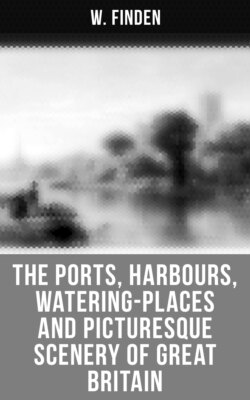Читать книгу The Ports, Harbours, Watering-places and Picturesque Scenery of Great Britain - W. Finden - Страница 30
На сайте Литреса книга снята с продажи.
BAMBROUGH CASTLE.
ОглавлениеTable of Contents
Bambrough, which is now a small village, was a place of considerable importance during the Saxon period. King Ida, who ascended the throne of Bernicia in 559, first built a castle there, which he is said to have named Bebban-burgh in honour of his queen Bebba. It has been conjectured by Wallis in his History of Northumberland, that the Keep or great tower, is of Roman origin; but Grose, with greater probability, considers it to have been built by the Normans. In 1095 Robert Mowbray, Earl of Northumberland, having rebelled against William Rufus, retired to Bambrough Castle, whither he was followed by Henry, the King's brother, and closely besieged. After the siege had continued some time, Mowbray left the castle in the charge of his kinsman Morel, who continued to defend it with great bravery. The Earl being afterwards seized at Tynemouth, where he had taken sanctuary, Henry caused him to be brought to Bambrough, and there showing him before the walls of the castle, he threatened to put out his eyes if it were not immediately delivered up—a proceeding which caused Morel to surrender the place forthwith.
From the reign of William Rufus till about the middle of the fifteenth century, Bambrough Castle, as if it were a place too important to be in the hands of a subject, appears to have continued in the possession of the crown, by whom a governor was appointed. In the frequent contests between the houses of York and Lancaster, it sustained great damage; and as it was not repaired either by Henry VII. or his successor, it ceased about the beginning of the sixteenth century to be a fortress of importance. In 1575 Sir John Foster, warden of the Middle Marches was governor of Bambrough Castle; and one of his descendants received a grant of the old building from James I. It continued in the possession of this family till the commencement of the reign of George I., when it was forfeited through the treason of Thomas Foster, Esq., M.P. for Northumberland, better known as General Foster, who in 1715 took up arms in favour of the Pretender.
The Manor and Castle of Bambrough were afterwards purchased of the crown, by Nathaniel, Lord Crewe, Bishop of Durham, who was married to Foster's aunt. Lord Crewe, at his decease in 1720, left the above property, with other valuable estates, to trustees to be applied to charitable uses. In compliance with the intentions of the testator, a noble charity is established at Bambrough for the succour of shipwrecked seamen, the education of children, and the relief of indigent persons. In 1757 part of the Keep being ready to fall down, the Rev. Thomas Sharp, Archdeacon of Northumberland, and one of Lord Crewe's trustees, caused it to be repaired, "merely because it had been a sea-mark for ages, and as such beneficial to the public." The Rev. Thomas Sharp being succeeded in the trusteeship, as well as in the archdeaconry, by his son, the Rev. John Sharp, D.D., the latter, who was also perpetual curate of Bambrough, continued to make further repairs; and he also caused an immense quantity of sand, which he had accumulated in the castle-yard, to be cleared away. To this gentleman, who was a brother of the amiable Granville Sharp, the present arrangements of the charity are chiefly owing. At the castle, blocks and tackles, anchors, cables, warps, and other articles are kept for the use of stranded vessels. In stormy weather, two men patrol the coast for eight miles, day and night, in order to look out for vessels in distress, and during a fog a bell is rung at intervals from the castle, and a gun fired every quarter of an hour, as a warning to such ships as may be near the coast. Flour and groceries are sold to poor families at a reduced rate, and twenty poor girls are boarded and educated within the castle.
HOLY ISLAND CASTLE. St. Cuthberts.
